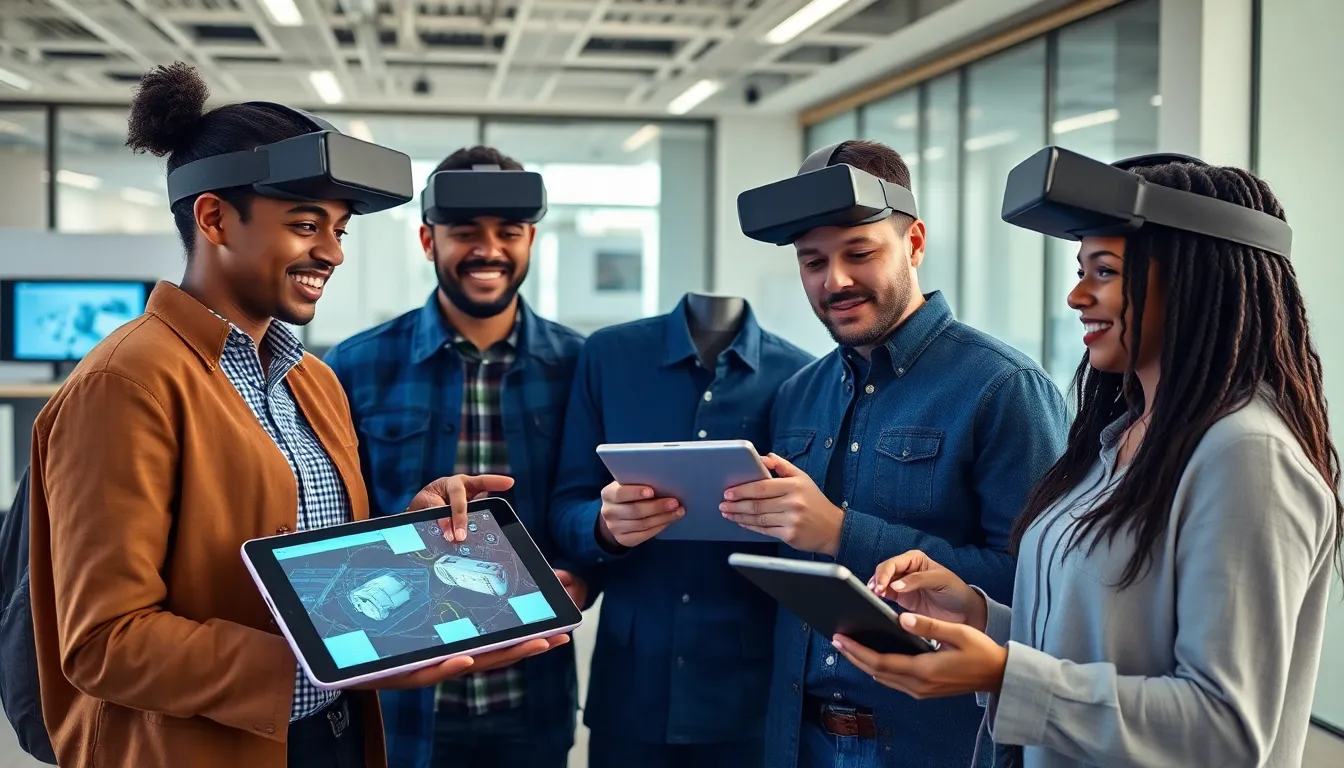Table of Contents
ToggleAugmented Reality (AR) software isn’t just a tech buzzword; it’s a game-changer that’s transforming how people interact with the world around them. Imagine pointing your phone at a boring old wall and suddenly seeing a vibrant mural pop up. It’s like magic but with fewer rabbits and more pixels. As businesses and consumers embrace AR, navigating this software can feel like trying to find your way out of a corn maze—exciting yet a tad overwhelming.
Overview of Navigate AR Software
Navigate AR software enhances user interactions by integrating digital elements into the real world, creating an immersive experience. This software stands out by offering intuitive interfaces that streamline navigation through AR environments. Users can manipulate virtual objects seamlessly, improving engagement and creativity.
Key features of Navigate AR software include precise location tracking, allowing users to position virtual items accurately. High-quality graphics contribute to a realistic experience, helping users visualize concepts better. The software supports multiple platforms, making it accessible across devices like smartphones and tablets.
Developers behind this software continually update features based on user feedback. New updates often enhance usability, addressing any challenges users face when navigating AR. Additionally, tutorials and support resources simplify the learning curve for beginners.
Industries such as education, architecture, and retail benefit significantly from this technology. In education, AR aids in visualizing complex subjects, while architects can present 3D models to clients. Retailers use it to create interactive shopping experiences, merging convenience with innovation.
Adoption of Navigate AR software creates opportunities for businesses and consumers alike. Engaging with this technology fosters creativity and enhances productivity. Understanding its capabilities opens doors to new applications, making it essential for organizations aiming to stand out in a competitive landscape.
Key Features of Navigate AR Software

Navigate AR software stands out due to its essential features that enhance user interactions and streamline the augmented reality experience.
User Interface and Experience
Intuitive design defines the user interface of Navigate AR software. Users find navigation smooth, enabling easy access to various tools and functions. Simplicity becomes paramount; even beginners navigate with confidence due to user-friendly layouts. Visual elements are designed for clarity, ensuring quick understanding of features. Feedback loops allow developers to refine the interface, enhancing overall satisfaction. Tutorials further support user adoption by breaking down complex tasks into manageable steps.
Integration Capabilities
Seamless integration characterizes Navigate AR’s compatibility with existing technologies. The software connects effortlessly with popular applications, enriching experiences across platforms. Real-time data usage enhances functionality, facilitating better decision-making in various industries. Collaborations with hardware like wearables and sensors expand capabilities significantly. Additionally, customization options enable businesses to tailor the software to specific needs, ensuring a personalized experience. This flexibility supports diverse applications, from education to retail, driving innovation and engagement.
Benefits of Using Navigate AR Software
Navigate AR software offers numerous advantages that enhance user experiences and interactions in augmented reality.
Improved Productivity
Improved productivity emerges as one of the key benefits of Navigate AR software. Users can manipulate digital elements seamlessly within their physical environments, enabling quicker task completion. High-quality graphics and precise location tracking assist in focusing attention on relevant details, reducing confusion. Tasks that once required extensive time get streamlined, leading to faster decision-making in various sectors. Organizations see an uptick in efficiency, allowing teams to allocate resources to more critical areas, thereby maximizing overall output.
Enhanced Collaboration
Enhanced collaboration is another significant advantage. Navigate AR software allows multiple users to interact with digital content simultaneously, breaking geographical barriers. Teams can visualize complex projects together, fostering a shared understanding and inventive problem-solving. Clear visual elements support effective communication, which minimizes misunderstandings and enhances project alignment. The ability to share insights in real-time creates a sense of teamwork, ultimately leading to improved results and innovation.
Use Cases for Navigate AR Software
Navigate AR software offers diverse applications across various industries, showcasing its versatility and effectiveness in enhancing user experiences.
In Manufacturing
Manufacturing processes benefit significantly from Navigate AR software. It improves assembly line efficiency by overlaying digital instructions onto physical equipment. Workers can receive real-time guidance, which reduces errors and speeds up training. Visualization of complex machinery allows for easier maintenance tasks. Quality control processes become more effective with AR, as inspectors can identify defects through enhanced imagery, ensuring products meet requirements. Data analysis, when integrated into AR displays, provides insights that drive operational improvements. Ultimately, Navigate AR fosters innovation and productivity in manufacturing environments.
In Healthcare
Healthcare settings also leverage Navigate AR software to enhance patient care. Surgeons utilize AR during operations, overlaying critical information on anatomical structures for precise procedures. Medical training programs benefit from immersive AR simulations, allowing students to practice skills in a safe environment. Patient education improves as healthcare providers use AR to demonstrate treatment plans visually, making complex medical concepts easier to understand. Rehabilitation programs incorporate AR to motivate patients during exercises, leading to better engagement and outcomes. Navigate AR significantly transforms healthcare delivery, improving communication and enhancing overall efficiency.
Challenges and Limitations
Navigating AR software presents several challenges that users and developers face. High computational demands often strain device capabilities, leading to performance issues. Users may experience lag or decreased responsiveness, detracting from the intended immersive experience.
Another significant challenge involves accurate tracking of physical environments. When users move, AR software must continually adjust digital elements to align with real-world surroundings. Inconsistent tracking can result in virtual objects appearing out of place, impacting usability.
Moreover, accessibility remains a limitation for some users. Not all devices support advanced AR features, creating disparities in user experiences. Cost can also pose a barrier, particularly for smaller businesses that may find investments in AR technology substantial.
User engagement with AR software often requires a learning curve. Although intuitive design aims to simplify navigation, some users may struggle with unfamiliar features. Ongoing updates and improvements can help mitigate this but may also lead to further confusion if not communicated effectively.
Privacy concerns also emerge with AR applications. Users often worry about how personal data is collected and used within AR experiences. Ensuring transparency in data practices is crucial for building trust among users.
Lastly, AR software’s effectiveness often depends on the quality of underlying content. Poorly designed or outdated digital elements can detract from the experience. Continuous collaboration between developers and content creators is essential to enhance the AR journey.
Addressing these challenges improves user experience and fosters wider adoption of AR technology across industries. By recognizing the limitations, developers can prioritize improvements in AR software, leading to stronger engagement and functionality.
Navigating AR software like Navigate AR opens up a world of possibilities for users across various industries. Its intuitive design and seamless integration with existing technologies make it an attractive choice for both beginners and seasoned professionals. By harnessing the power of AR, businesses can enhance productivity and collaboration while visualizing complex concepts in innovative ways.
Despite some challenges such as device limitations and privacy concerns, the benefits of adopting Navigate AR software far outweigh the drawbacks. As technology continues to evolve, organizations that embrace AR solutions will not only improve their operational efficiency but also stay ahead in a competitive landscape. The future of augmented reality is bright, and Navigate AR is leading the charge.




